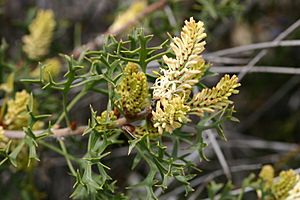Conebushes facts for kids
Quick facts for kids Conebushes |
|
|---|---|
 |
|
| Petrophile macrostachya | |
| Scientific classification |
|
| Kingdom: | Plantae |
| Clade: | Tracheophytes |
| Clade: | Angiosperms |
| Clade: | Eudicots |
| Order: | Proteales |
| Family: | Proteaceae |
| Subfamily: | Proteoideae |
| Tribe: | Petrophileae |
| Genus: | Petrophile R.Br. ex Knight |
| Type species | |
| Petrophile pulchella |
|
| Species | |
|
See text |
|
| Synonyms | |
|
|
Petrophile plants are a group of evergreen shrubs, often called conebushes. They belong to the Proteaceae family. You can only find these unique plants in Australia. Conebushes usually have spiky, divided leaves. They grow pretty pink, yellow, or cream-colored flowers. After the flowers, they produce cool grey, cone-shaped fruits.
Contents
What's in a Name?
The name Petrophile was first officially used in 1809. It was described by Joseph Knight. Another botanist, Robert Brown, also used the same name later.
The name Petrophile comes from two ancient Greek words: petra meaning "rock" and philos meaning "seeking" or "preferring". This name makes sense because some of these plants love to grow in rocky places!
Many Kinds of Conebushes
There are many different types of Petrophile species. The Australian Plant Census keeps track of all the accepted species and subspecies. Most of these plants are found in Western Australia.
Where Conebushes Grow
Most Petrophile species grow in Western Australia. However, you can also find some types in other Australian states. These include South Australia, New South Wales, and Queensland.
Growing Conebushes at Home
If you want to grow these plants, especially those from Western Australia, they need special soil. They like soil that drains water very well. Conebushes can handle dry periods and light frosts. They grow best in full sun or a bit of shade.
You can start new conebush plants from cuttings taken in autumn. You can also grow them from seeds. However, getting new plants to grow using either method can sometimes take a while.
See also
 In Spanish: Petrophile para niños
In Spanish: Petrophile para niños

